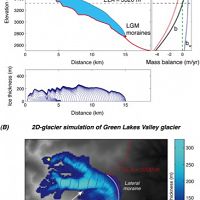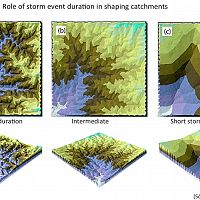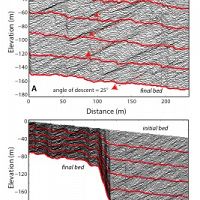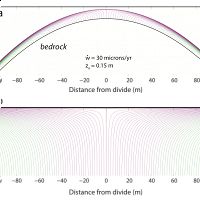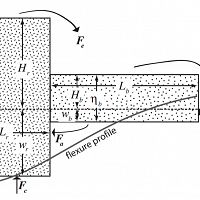Numerical Models
One of the methods we have employed to explore the Boulder Creek CZO is numerical modeling. In most cases, we target specific forms or functions of the critical zone and develop models that allow us to assess the interactions of the processes responsible for evolution of the system. These models range in complexity, span from 1D to 2D, and have been written in a variety of coding languages.
Alpine glaciers 1&2D
Numerical models of alpine glaciers in 1 and 2 dimensions
Computes glacial ice motion including internal deformation and sliding in flowline (1D) or in planview (2D) in an alpine valley
CHILD
Channel-Hillslope Integrated Landscape Development (CHILD) model
Computes time evolution of a topographic surface z(x,y,t) by erosion (fluvial, hillslope) and sediment transport
Digital glacier bed
Digital model of glacier bed
Computes evolution of a glacial bed at the 1-meter scale , mimicking both abrasion and block removal by quarrying
GullyErosionProfiler
1D model of gully longitudinal profile evolution
Calculates the long-profile evolution of a gully channel containing an abrupt step (headcut).
Hillslope trajectory
Hillslope trajectory model
Combination of analytical and numerical methods captures soil particle trajectories on a steady state hillslope
Landlab
Landlab: A Python-language library for 2D numerical modeling
Landlab enables researchers to efficiently create and/or combine 2D numerical models.
Range and Basin
Range and Basin: A Simple Model of Mountain Range and Basin Evolution on a Flexing Lithosphere
Computes the time evolution of mean elevation and “extra” crustal thickness for a hypothetical mountain range and adjacent forel
Root deformation
Particle model to simulate soil deformation associated with roots
Employs the discrete element model LIGGGHTS to compute displacement of particles in near-surface soil
VS2Di
Using VS2Di to study aspect-related controls on vadose-zone moisture
2D model of subsurface moisture dynamics in the vadose zone. Model written by R. Healy, USGS.
Numerical model of a 200 m long stretch of a bedrock river bed. River flows left to right, down a slope initially chosen to be uniform. Bed consists of rock with a prescribed distribution of block sizes (red profile). Bed is locally covered by alluvium, the top of which is painted green, that fills depressions and prevents bedrock erosion. Quarrying or plucking of blocks (pink dots) occurs preferentially at negative steps in the bed, promoting up-river migration of steps or micro-knickpoints.
Numerical model of Boulder Creek evolution over several million-year timescales. Initial profile is green, based upon projection of modern profile shown in blue downstream past modern location of major knickpoint at ~ 70 km. Stream-power rule is invoked, with modern catchment geometry governing the water discharge. Soft rock of the high plains allows efficient erosion at distances < 60 km from lefthand edge of the calculation space, and hard rock of the crystalline core of the Front Range allows only inefficient erosion upstream of this. Isostatic adjustment of the entire space occurs in response to the removal of rock, dominated by the widespread erosion of the High Plains rock mass. Fianl profile matches well the modern profile of Boulder Creek downstream of the glacially-dominated headwaters, which are not captured in this model.
References:
Anderson, R.S., Riihimaki, C.A., Safran, E. B., MacGregor, K.R., 2006, Facing reality: Late Cenozoic evolution of smooth peaks, glacially ornamented valleys and deep river gorges of Colorado’s Front Range. In Willett, S.D., Hovius, N., and Brandon, M.T., and Fisher, D.M., eds., Tectonics, climate and landscape evolution, GSA Special Paper 398 (Chapter 25) p. 397-418.
Anderson, S. P., R. S. Anderson, and G. Tucker, 2012, Landscape scale linkages in critical zone evolution, Comptes Rendus Geoscience 344(11-12): 586-596. doi:10.1016/j.crte.2012.10.008
Please also see our modeling playlist on our YouTube Channel.
Explore Further
